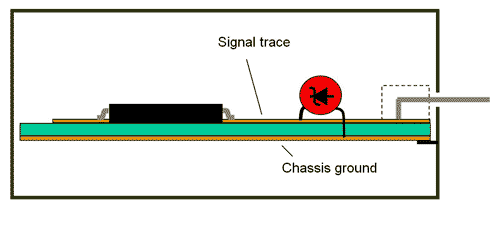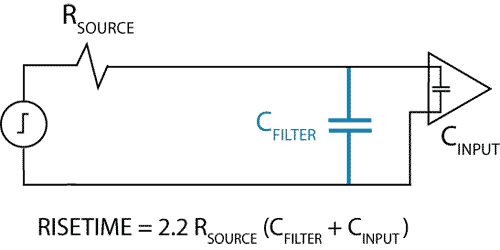Transient Protection
Transients (momentary spikes in voltage or current) can disrupt or damage the products connected to signal or power lines. Common sources of transients energy coupled from lightning, electrostatic discharge and circuits experiencing a sudden change in current due to a switch opening or a short occurring.
Transient protection devices attempt to re-direct the energy in these transients by taking advantage of the differences between the transient waveform and the intended signal or power waveform. The most common transient protection schemes limit the voltage amplitude, current amplitude or transition times on the circuit they are protecting.
Voltage-Limiting Devices
Figure 1 illustrates how a voltage limiting transient protection device might be used to protect an input of a VLSI component mounted on a printed circuit board. At normal signal or power voltages, the device has a high-impedance and does not significantly affect the operation of the circuit. However, if the voltage across the device exceeds a threshold, the impedance across its terminals decreases suddenly diverting current from the component being protected.

Figure 1. Voltage-limiting transient protection on a printed circuit board.
Diodes
Diodes are perhaps the most common protection device for low-voltage applications. An unbiased diode generally has a high impedance when the potential across its terminals is below about 0.5 volts. The impedance drops quickly at higher voltages. Diodes can be combined in series to reach higher threshold voltages or reversed-biased Zener diodes can be employed. Generally, diodes are used in applications requiring a threshold voltage of anywhere from 0.5 to a few volts.
Diodes are voltage limiting devices, which means they conduct just enough current to hold the voltage to the threshold level. They are relatively fast acting with response times fast enough to protect sensitive semiconductor inputs. However, diodes are generally incapable of dissipating much energy before they fail. A failed diode may look like an open circuit or a short circuit, but is more likely to fail short.
Varistors
Varistors are another type of voltage limiting device often made from metal oxide powder. Varistors can be designed to have threshold voltages anywhere from 0.5 volts to 10s of volts. They are generally capable of dissipating more energy than diodes, but they are also likely to have more parasitic capacitance, which may make them unsuitable for high-speed signal applications. Like diodes, they are more likely to fail short than open.
Thyristors
Thyristors are semiconductor devices like diodes. They are generally capable of dissipating much more energy than diodes however, and they can be found with a variety of threshold voltages. Unlike diodes and varistors, thyristors are crowbar devices, which means that they effectively “short out” when their threshold voltage is exceeded and the voltage across them drops to near zero.
Gas Discharge Devices
Lightning protection for early telephone equipment in homes consisted of two pointed pieced of metal in close proximity. When the voltage across these metal pieces exceeded the threshold, the air between the metal pieces would break down forming an arc. This is still an effective transient protection scheme for large voltages, but today’s devices are enclosed in a glass or plastic tube filled with a gas that breaks down more predictably than air.
Gas discharge tubes are capable of dissipating relatively large amounts of energy without being damaged. They also have relatively low capacitance, so they are less likely to distort fast or high-frequency signals. They are generally designed with threshold voltages anywhere from 10s to 100s of volts and are crowbar devices like thyristors.
Gas discharge tubes are likely to fail open making it difficult to tell whether they are working properly. However, a failed discharge tube will not interfere with normal operation of the device it is connected to. Neon bulbs behave like gas discharge tubes and can be an inexpensive way to provide primary transient protection (threshold ~70 volts) for many applications.
Current-Limiting Devices
Devices such as fuses, circuit breakers and thermal protection devices are triggered by current rather than voltage. These devices are placed in series with the power or signal lines leading to the equipment being protected. They normally have a very low impedance, but open (become a high impedance) when too much current flows through them. Once they are triggered, current limiting devices block power from reaching the equipment being protected without having to dissipate that power as heat. Therefore, there is virtually no limit to the amount of energy (or power) that they can handle. However, current-limiting devices do not generally respond fast enough to protect equipment from the fast transients generated by lightning or electrostatic discharge.
Transition-Time Limiting Devices
Voltage and current limiting devices take a finite amount of time to respond. If the transient is fast, the damage may occur before the protection device has a chance to operate. Often, the best transient protection is a simple capacitor or ferrite bead designed to slow any change in voltage or current due to an induced transient.
Figure 2 illustrates how a capacitor on a sensitive input to a VLSI component can slow the risetime associated with any transients induced. Often, integrated circuit inputs will respond to very fast transients even when this is not required for the proper operation of the device. For example, the reset input on a microprocessor is not generally switched on a frequent basis. When it is switched, it normally doesn't matter if the switching occurs in microseconds or milliseconds. Nevertheless, these inputs often respond to transients on the order of nanoseconds. Slowing these inputs by adding a shunt capacitor, can eliminate problems due to very fast transients (e.g. those resulting of ESD) without having any adverse effect on the operation of the device.

Figure 2. Using a filter capacitor to slow the response of a fast input.
Capacitors have several advantages over other transient protections devices. They are relatively small, inexpensive and their linear behavior is relative easy to predict and model. They have a relatively large energy storage capacity compared to the devices they protect, so they are not likely to fail if properly sized. Although capacitors generally behave like short circuits when exposed to voltages higher than their rated value, their behavior under these conditions is not reliable; so capacitors should not be used as voltage-limiting transient protection devices.
Ferrite beads or resistors can be used to provide transition-time limiting transient protection for low-impedance (e.g. high-capacitance) inputs. Ferrite beads have the advantage that no DC voltage is dropped across them. However, when using a ferrite bead, it is important to ensure that the signal or power currents do not saturate the ferrite material.
